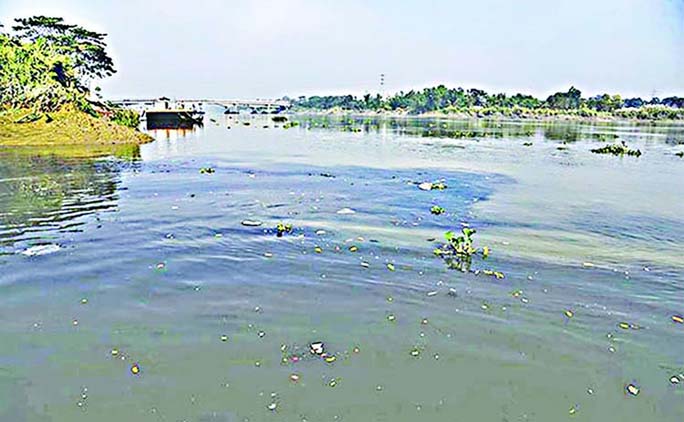
Chattogram Bureau :
The discharge of industrial effluents into the Halda River is causing depletion of fish stocks. Halda River is vitally important because it is the only place in the country where naturally-laid carp eggs can be gathered for hatching.
Unfortunately, DoE’s probe has found that a number of industries are directly responsible for polluting the river. no effective steps have been taken to take the polluters to task. With some 18 canals connected to the Halda River, the pollution has spread and despite being armed with detailed laboratory tests.
Halda River is a river in south-eastern Bangladesh. It originates at the Badnatali Hill Ranges in Ramgarh Upazila in the Chattogram Hill Tracts, flows through Fatikchhari Upazila, Bhujpur Thana, Hathazari Upazila, Raozan Upazila and Chandgaon Thana of the Chattogram Metropolitan City, and falls into the Karnaphuli River.
The 81-kilometre long river has a very turbulent tributary, the Dhurung River, which joins Purba Dhalai about 48 kilometres downstream. The river is navigable by big boats 29 km into it and by small boats 16-24 km further. The Halda reaches up 21 feet in depth and 30 feet in deepest point. The Halda river is also famous for breeding pure Indian carp. This is the only pure Indian carp breeding field of Bangladesh, perhaps in South Asia.
Although many industries in the area have claimed that they use effluent treatment plant (ETP), there are some industries that are not using them. There are various types of activity going along the banks of the river ranging from housing estates to tannery, paper mill, power plant, etc. and it is the job of authorities to protect both the river and fisher folk communities that depend on the river for their livelihoods.
In a country where there is no dearth of legislation but where the implementing agencies remain weak and ineffective, The Chattogram Development Authority has stated it will act once the final report is published.
As its water has got extremely polluted which led to the death of various species of fish, the Halda River Protection Committee has put forward an 11-point recommendation to save the River Halda, the largest fish spawning ground in the country. Committee president Manzoorul Kibria, also a professor of Chittagong University’s zoology department, came up with the recommendations at a press conference at Chittagong Press Club recently.
The suggestions include making it mandatory to install and use effluent treatment plants in all industries, including Hathazari Peaking Power Plant and Asian Paper Mills, from Oxygen to Kulgaon to treat industrial waste, permanently stopping dumping of waste into the Mora Chora canal at Nandirat, taking effective measures to check pollution by poultry farms set up haphazardly, re-excavating Bamonshahi canal which was grabbed in Ananya Residential
The discharge of industrial effluents into the Halda River is causing depletion of fish stocks. Halda River is vitally important because it is the only place in the country where naturally-laid carp eggs can be gathered for hatching.
Unfortunately, DoE’s probe has found that a number of industries are directly responsible for polluting the river. no effective steps have been taken to take the polluters to task. With some 18 canals connected to the Halda River, the pollution has spread and despite being armed with detailed laboratory tests.
Halda River is a river in south-eastern Bangladesh. It originates at the Badnatali Hill Ranges in Ramgarh Upazila in the Chattogram Hill Tracts, flows through Fatikchhari Upazila, Bhujpur Thana, Hathazari Upazila, Raozan Upazila and Chandgaon Thana of the Chattogram Metropolitan City, and falls into the Karnaphuli River.
The 81-kilometre long river has a very turbulent tributary, the Dhurung River, which joins Purba Dhalai about 48 kilometres downstream. The river is navigable by big boats 29 km into it and by small boats 16-24 km further. The Halda reaches up 21 feet in depth and 30 feet in deepest point. The Halda river is also famous for breeding pure Indian carp. This is the only pure Indian carp breeding field of Bangladesh, perhaps in South Asia.
Although many industries in the area have claimed that they use effluent treatment plant (ETP), there are some industries that are not using them. There are various types of activity going along the banks of the river ranging from housing estates to tannery, paper mill, power plant, etc. and it is the job of authorities to protect both the river and fisher folk communities that depend on the river for their livelihoods.
In a country where there is no dearth of legislation but where the implementing agencies remain weak and ineffective, The Chattogram Development Authority has stated it will act once the final report is published.
As its water has got extremely polluted which led to the death of various species of fish, the Halda River Protection Committee has put forward an 11-point recommendation to save the River Halda, the largest fish spawning ground in the country. Committee president Manzoorul Kibria, also a professor of Chittagong University’s zoology department, came up with the recommendations at a press conference at Chittagong Press Club recently.
The suggestions include making it mandatory to install and use effluent treatment plants in all industries, including Hathazari Peaking Power Plant and Asian Paper Mills, from Oxygen to Kulgaon to treat industrial waste, permanently stopping dumping of waste into the Mora Chora canal at Nandirat, taking effective measures to check pollution by poultry farms set up haphazardly, re-excavating Bamonshahi canal which was grabbed in Ananya Residential

